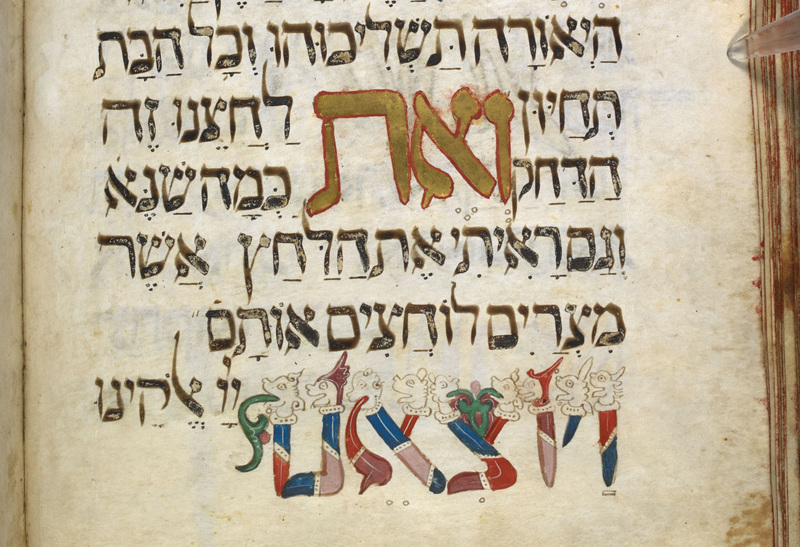Golden Haggadah
Type:
Illuminated manuscripts,
Haggadot
Date:
1320s
Location or Findspot (Modern-Day Country):
Spain
Dimensions:
24.5 × 19/20 cm
Description:
The haggadah is a service book that guides Jewish families through the the Passover Seder, the ritualized meal during which they recall their enslavement in Egypt and exodus toward the land promised to them by God. Stand-alone haggadot began to be produced and illustrated around 1300. The Golden Haggadah, made in Catalonia (probably Barcelona), includes fifty-six narrative scenes on tooled and diapered gold-leaf backgrounds, from which it takes its name. Like the Hebrew texts themselves, the scenes in their two-by-two grids are "read" from right to left. In addition to narrative illustration, the Golden Haggadah includes zoomorphic letters and hybrid creatures similar to those one might find in contemporary Christian books.
The full-page illuminations, which are grouped at the front of the manuscript, depict scenes from Genesis—the backstory to Passover—followed by Exodus and preparations for the seder, the ritualized family meal that commemorates the Jews' exodus from Egypt. On fol. 15v, the prophet Miriam, Moses's sister, dances with other women to celebrate the Jews' successful passage through the Red Sea (Ex. 15:20). They are accompanied by musical instruments: a lute, cymbals, clappers, and round- and square-frame drums. Passover preparations begin immediately after this historical scene: the elevated master of the house oversees distribution of round matzos and charoset (a paste, today made with dates or apples, reminiscent of the mortar the Jews used as they labored in Egypt). At the lower right, the house is thoroughly cleaned for Passover; and in the final scene, lambs are slaughtered and utensils boiled to remove traces of leaven. This commemorates that the Jews were in such haste to leave Egypt that their bread did not have time to rise, which is why unleavened matzo is eaten during Passover.
On fol. 44v is a circle patterned with Islamicate-looking interlace and with a tiny golden door at its center. The large gold title on the page says "this matzo," and the circular form is a stylized matzo (factory-made square matzos replaced round ones in North America in the twentieth century). The miniature door evokes the biblical "gate of the Lord, through which the righteous may enter" (Ps. 118:19–20), an important metaphor for salvation in Kabbalah, a mystical strand of Judaism that was codified in Spain in the thirteenth century. The matzo itself became a manifestation of God. The prominent round matzo depicted here and in other Sephardic haggadot also evoked the (round) host used in the Christian mass. It was thus a polemical device meant to indicate that God favored the Jews and their ritual bread.
The full-page illuminations, which are grouped at the front of the manuscript, depict scenes from Genesis—the backstory to Passover—followed by Exodus and preparations for the seder, the ritualized family meal that commemorates the Jews' exodus from Egypt. On fol. 15v, the prophet Miriam, Moses's sister, dances with other women to celebrate the Jews' successful passage through the Red Sea (Ex. 15:20). They are accompanied by musical instruments: a lute, cymbals, clappers, and round- and square-frame drums. Passover preparations begin immediately after this historical scene: the elevated master of the house oversees distribution of round matzos and charoset (a paste, today made with dates or apples, reminiscent of the mortar the Jews used as they labored in Egypt). At the lower right, the house is thoroughly cleaned for Passover; and in the final scene, lambs are slaughtered and utensils boiled to remove traces of leaven. This commemorates that the Jews were in such haste to leave Egypt that their bread did not have time to rise, which is why unleavened matzo is eaten during Passover.
On fol. 44v is a circle patterned with Islamicate-looking interlace and with a tiny golden door at its center. The large gold title on the page says "this matzo," and the circular form is a stylized matzo (factory-made square matzos replaced round ones in North America in the twentieth century). The miniature door evokes the biblical "gate of the Lord, through which the righteous may enter" (Ps. 118:19–20), an important metaphor for salvation in Kabbalah, a mystical strand of Judaism that was codified in Spain in the thirteenth century. The matzo itself became a manifestation of God. The prominent round matzo depicted here and in other Sephardic haggadot also evoked the (round) host used in the Christian mass. It was thus a polemical device meant to indicate that God favored the Jews and their ritual bread.
Relevant Textbook Chapter(s):
9
Repository and Online Resources:
• Read more about the Golden Haggadah on the website of the British Library.
• Watch the British Library's video on the Torah, Talmud, and Haggadah.
Image Credits:
British Library, Add. MS 27210 online







